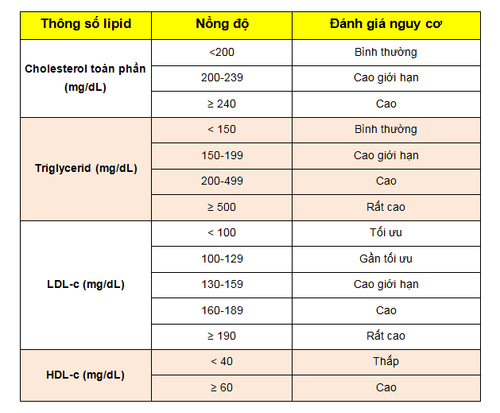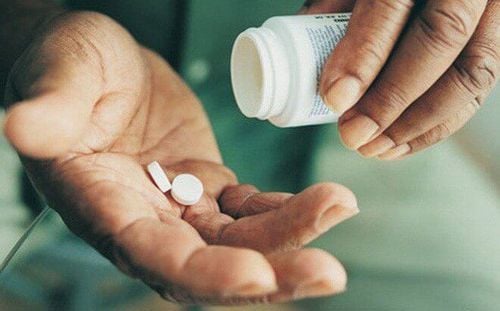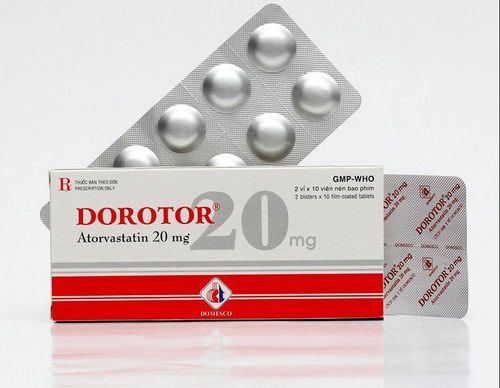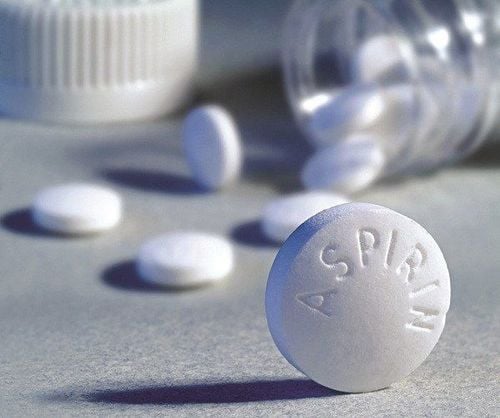This is an automatically translated article.
Dyslipidemia is the main cause of myocardial infarction, stroke and many other cardiovascular diseases. Blood cholesterol levels that fall within different ranges help assess a person's risk for cardiovascular disease.
1. Dyslipidemia and cardiovascular disease
Dyslipidemia is a dangerous disease but it is very silent, causing serious consequences and tends to increase in modern life.
According to research by the World Health Organization, hyperlipidemia is associated with 48% of cases of cerebrovascular accident and 56% of cases of myocardial ischemia worldwide. Each year, about 28 million people die from diseases related to dyslipidemia.
According to the Vietnam National Institute of Nutrition, more than 29% of Vietnamese adults have dyslipidemia, of which this rate in urban dwellers is up to 44.3%.
2. What is dyslipidemia?
Dyslipidemia is a medical condition when one or more lipid parameters are disturbed, for example:
Increased cholesterol, plasma triglycerides or both. Decreased levels of high-molecular-weight lipoprotein (HDL-c). Increased low-molecular-weight lipoprotein (LDL-c) levels. Recognizing lipid disorders as early as possible helps contribute to the treatment of the etiology of many cardiovascular, endocrine, and metabolic diseases. However, dyslipidemia is a biological pathology, occurring after a long time that is difficult to recognize, because there are no specific symptoms. Most symptoms of dyslipidemia are detected only when high levels of lipid components persist or cause complications in many other organs.
Therefore, the diagnosis of dyslipidemia can be suggested when a person has many signs or risk factors such as: Obesity, cardiovascular disease, blood pressure, diabetes...
Diagnosis is confirmed by blood lipid tests. When patients go to do blood lipid tests, it should be noted that lipid parameters increase after eating. Therefore, to ensure an accurate diagnosis, it is necessary to draw blood without eating (when hungry).
3. Assess the status of dyslipidemia through indicators
Limits of blood lipid levels help warn of the risk of cardiovascular complications. In the test, the parameters commonly examined to assess the status of dyslipidemia are:
Blood cholesterol Triglyceride LDL-Cholesterol (LDL-c) HDL-Cholesterol (HDL-c) Below is a table to evaluate the disorder. Blood lipids according to the Updated Guidelines for the Treatment of Hypercholesterolemia in Adults (NCEP ATP III - USA, 2001):

Bảng đánh giá rối loạn lipid máu theo NCEP ATPIII (2001)
3.1. Total cholesterol A total cholesterol of < 200 mg/dL (5.1 mmol/L) is considered ideal and your risk of coronary artery disease is low.
From level 200 onwards, is the borderline, and if the total cholesterol level is ≥ 240 mg/dL (6.2 mmol/L), it means that you are having hypercholesterolemia. People with this level are often twice as likely to have coronary artery disease than the general population.
3.2. Triglycerides Triglycerides are also a form of body fat. Elevated triglycerides are common in people who are obese/overweight, inactive, smoking, diabetes, drinking too much alcohol...
People with elevated blood triglycerides are often accompanied by increased total cholesterol, increased cholesterol. LDL (the bad kind) and lower HDL (the good). As can be seen, a triglyceride level of < 150 mg/dL (1.7 mmol/L) is normal. If your tryglyceride levels are higher, your risk of cardiovascular disease due to cholesterol is increasing. A triglyceride level of ≥ 500 mg/dL (≥ 5.6 mmol/L) is an extremely dangerous high-risk warning level.
3.3. HDL cholesterol (good) HDL-c is a type of good cholesterol, accounting for about 1/4 - 1/3 of the total cholesterol in the blood. HDL-c is responsible for transporting cholesterol from the blood back to the liver, transporting cholesterol away from the atherosclerotic plaques of blood vessels, thereby reducing the risk of atherosclerosis as well as other serious cardiovascular events.
The lower the HDL-c level, the higher the risk for cardiovascular disease.
Normally, HDL-c levels are usually < 40 mg/dL (1.0 mmol/L) for men and < 50 mg/dL (1.3 mmol/L) for women.
If HDL-c is > 60 mg/dL (1.5 mmol/L) it means that the concentration of this lipid is increased. This is a good thing and can contribute to protecting the body against the risk of cardiovascular disease.
3.4. LDL Cholesterol (bad) LDL-c concentration is considered one of the important indicators to monitor during treatment. This is considered a "bad" cholesterol component, when this amount of LDL-c is increased a lot in the blood, it leads to easy deposition in the walls of blood vessels (especially in the heart and in the brain) and causes atherosclerotic plaques. circuit. This atherosclerotic plaque is gradually formed, causing narrowing or occlusion of blood vessels or it may burst suddenly causing acute occlusion of blood vessels leading to dangerous diseases such as myocardial infarction, cerebral stroke,...
LDL-c <100 mg/dL (<2.6 mmol/L) is considered very good. The higher the LDL-c level, the higher the risk of cardiovascular disease, to ≥ 190 mg/dL (4.9 mmol/L) means that the blood lipid level is at an alarming level, requiring measures to be taken. timely control.
Recognize the limits of blood lipids to help control blood fat problems, limit cardiovascular problems, especially atherosclerosis, stroke,... risk factors, or age over 40 should have the habit of screening for cardiovascular diseases, blood tests, periodic health check-ups to get the best health.
Currently, Vinmec International General Hospital is deploying Cardiovascular screening packages from basic to advanced. Here, with a team of doctors - doctors who are leading experts in the industry, a system of modern equipment, cardiovascular examination at an international general hospital is the first choice in health care for patients.
Please dial HOTLINE for more information or register for an appointment HERE. Download MyVinmec app to make appointments faster and to manage your bookings easily.
Article referenced source: Department of Preventive Medicine












